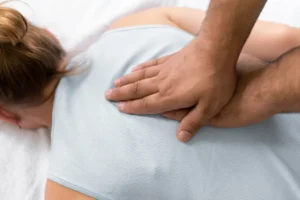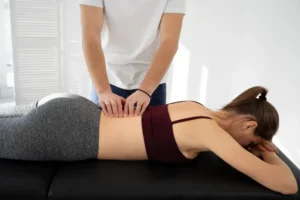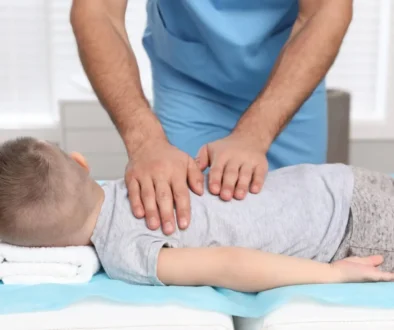Massage For Back Pain
Back pain affects millions of people every year and can make even simple tasks feel difficult. While there are many ways to manage it, more and more people choose massage therapy as a gentle, natural option. Back massage doesn’t just ease tension – it can also provide a wide range of additional benefits to support the spine over time without the need for medications or surgery.
How Massage Therapy Works with Back Pain
Massage therapy works by using hands-on back massage techniques to relax tight muscles, improve blood flow, and help with natural healing. A licensed therapist may use their hands, elbows, or forearms to gently knead or press on sore areas. Depending on what your body needs, the pressure can range from very light to deep and firm.
Back pain is often caused by tension, stiffness, or less movement in the muscles and joints. Back massage can help loosen up these tight areas and make it easier for your spine and surrounding muscles to function properly. It can also reduce painful spasms, ease pressure on nerves, and improve blood circulation.
In many cases, massage is used in conjunction with other treatments like physical therapy or chiropractic care. Together, they help treat pain, restore mobility, and be useful in the long run. For chronic back pain, massage may also reduce stress and improve sleep, helping you feel better both physically and mentally.
Causes of Back Pain
- Muscle Strain or Tension. Overworking your muscles – like lifting something too heavy or sitting too long in the wrong position – can lead to strained muscles or tiny tears in the tissue, which can cause soreness and stiffness.
- Poor Posture. Slouching at a desk, looking down at your phone often, or standing unevenly can all put stress on your spine. With time, poor posture can cause pain, especially in the lower back or neck.
- Herniated or Bulging Discs. Discs act like cushions between your vertebrae. If one shifts out of place or breaks open, it can press on a nerve and cause sharp or shooting pain.
- Joint Issues (Arthritis or Wear and Tear). As we age, the joints in the spine can wear down. This can cause inflammation, stiffness, and pain – especially with conditions like osteoarthritis or degenerative disc disease.
- Pinched Nerves (like Sciatica). If a nerve is compressed – like by a disc, tight muscle, or swollen tissue – it can send pain down your leg or arm. Sciatica is a common example, caused by pressure on the sciatic nerve.
- Injury or Trauma. Falls, accidents, or sudden movements can damage muscles, ligaments, discs, or bones in the back, leading to pain that can last days or even longer if not treated.
- Stress and Tension. Emotional stress often shows up in the body as tight muscles, especially in the neck and shoulders. Over time, this can even cause back pain, headaches, and fatigue.
- Body Problems. Conditions like scoliosis (a sideways curve of the spine) or uneven leg length can affect how your body moves and carries weight, causing back discomfort.
Back Massage Techniques for Treating Lower Back Pain
Lower back pain is one of the most common reasons people seek out massage therapy for back pain. A targeted back pain massage can help relax tense muscles, improve blood flow, and ease pressure on nerves. Depending on your needs, massage therapists may use a mix of hands-on methods to reduce pain and improve how your back moves and feels. All in all, different types of massage for back pain are better suitable for different causes of back pain.
Hot Stone Massage for Back Pain
Hot stone massage uses smooth, heated stones to help relax muscles, boost blood circulation, and ease tension. The therapist places warm stones along both sides of your spine and may use them to gently massage your back and legs. The heat helps release tight spots, reduce cramps, and make stiff muscles feel softer. Many people find it especially calming and helpful for long-term back pain caused by stress, tightness, or past injuries.
Deep Tissue Massage & Trigger Point Therapy for Back Pain
Deep tissue back pain relief massage uses slow, firm pressure to reach deep layers of muscles and break up tight knots. It’s great for easing long-term back pain, especially in people with muscle tension or old injuries. Therapists usually target specific “trigger points” – which are painful spots that can cause aches in other areas. This massage may feel intense during the session, but for many patients it’s a great way to achieve lasting results. Some soreness is normal afterward, but it usually fades quickly.
Therapeutic Massage for Back Pain
Therapeutic massage focuses on easing pain and tension in specific problem areas, like the lower or upper back. This massage for lower back pain is more clinical than a typical spa massage and is done by trained professionals who understand how muscles, tendons, and soft tissues work. Techniques like deep tissue work, trigger point therapy, or stretching may be used depending on your condition and health needs. While it can feel intense at times, this type of massage can help your body heal itself better and faster.
Swedish Massage for Back Pain
Swedish massage is what most people think of as a classic, relaxing massage. It uses gentle to medium pressure and smooth strokes to relax muscles and calm the body. Therapists may also use oils to help glide over the skin and may include light tapping or gentle friction. While it doesn’t go deep, it’s great for easing tension, improving blood circulation, and helping you unwind. It’s great for relaxation but also provides practical benefits for your health.
Myofascial Release for Back Pain
Myofascial release is a hands-on technique that targets tight spots in the muscles and surrounding tissues, called fascia. A therapist gently presses and stretches these stiff areas to help reduce pain and improve movement. It’s often used when back pain comes from tension or “trigger points” that don’t go away on their own. By easing that pressure, this therapy can help your muscles feel looser and more flexible.
Side Effects of Massage Therapy for Back Pain
Most people feel better after a massage, but there are still certain side effects to consider, especially if the pressure was deep or the body isn’t used to it. You might feel sore, tired, or even get a slight headache. Some people bruise easily or feel achy in the treated areas for a day or two.
These reactions are usually short-term and go away quickly. Side effects depend on how much pressure was used, how well you tolerate pain, and how your body responds. Always inform your massage therapist of what you feel and whether you’re comfortable about your massage.
When Massage Therapy for Back Pain Is Contraindicated
There are times when it’s better to wait or skip it. If you have a fever, infection, open wounds, or skin rashes in the area, massage could make things worse. It’s also not recommended right after a serious injury, like a recent fall or accident, unless your doctor says it’s okay.
People with certain health conditions – like blood clots, severe osteoporosis, or uncontrolled high blood pressure – should talk to a doctor first. If you’re unsure, always check with a healthcare provider before starting massage therapy.
Conclusion
Back pain can affect your daily life, mood, and ability to move comfortably – but you don’t have to manage it alone. From gentle Swedish massage to focused deep tissue and myofascial release, massage therapy offers a huge range of options to battle discomfort and support health and recovery.
At Cross-Up Chiropractic, you’ll find skilled professionals who understand how to combine hands-on care with a fully personalized approach. Whether you’re looking for a chiropractic clinic in Libertyville, a scoliosis chiropractor, or a herniated disc chiropractor, the right support can make all the difference in how you feel and heal.
FAQs About Massage for Back Pain
What Massage is Best for Back pain?
The best massage for back pain depends on what causes your pain and how severe your symptoms are. Swedish massage is great for general tension and relaxation, while deep tissue or trigger point therapy targets tight knots and chronic pain. A licensed therapist can help choose the best option based on your specific needs.
Is Massage Good for Lower Back Pain?
Sure, lower back pain massage can be very helpful for lower back pain. It relaxes tight muscles, improves blood flow, and may reduce pressure on nerves. It can be highly useful for both short-term and long-term issues.
What Type of Massage is Best for Lower Back Pain?
For lower back pain, deep tissue massage and myofascial release are usually the most effective. They target deep muscle tension and tight connective tissue that can cause pain. Swedish massage is a good option if you need something gentler or if you need some deep relaxation.
Is Massage Safe if I Have a Herniated Disc?
Massage is safe for a herniated disc when done by a trained professional who understands your condition. Gentle back massage techniques may help reduce tension and help you feel more comfortable, but deep pressure on the affected area should be avoided. Always talk to your doctor or herniated disc chiropractor before starting massage therapy.
What Type of Massage is Best for Back Pain?
Deep tissue massage is often best for back pain caused by tight muscles or chronic tension, while Swedish massage works well for general soreness and stress-related pain. Myofascial release can help if your pain is caused by stiff connective tissue. There is no single “best massage for back pain,” because “the best” is defined by what causes your pain.








